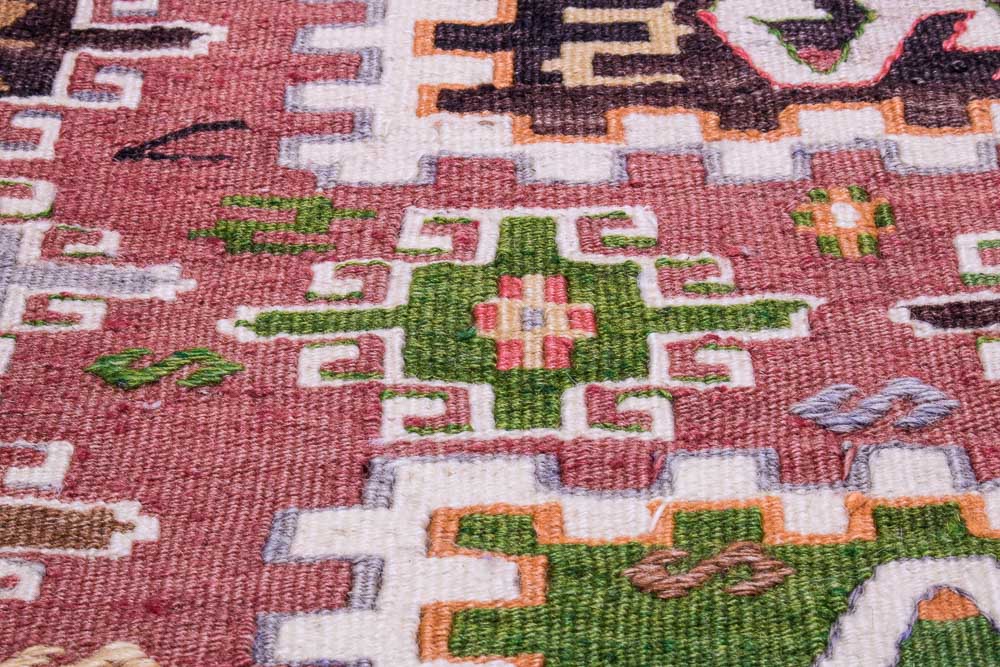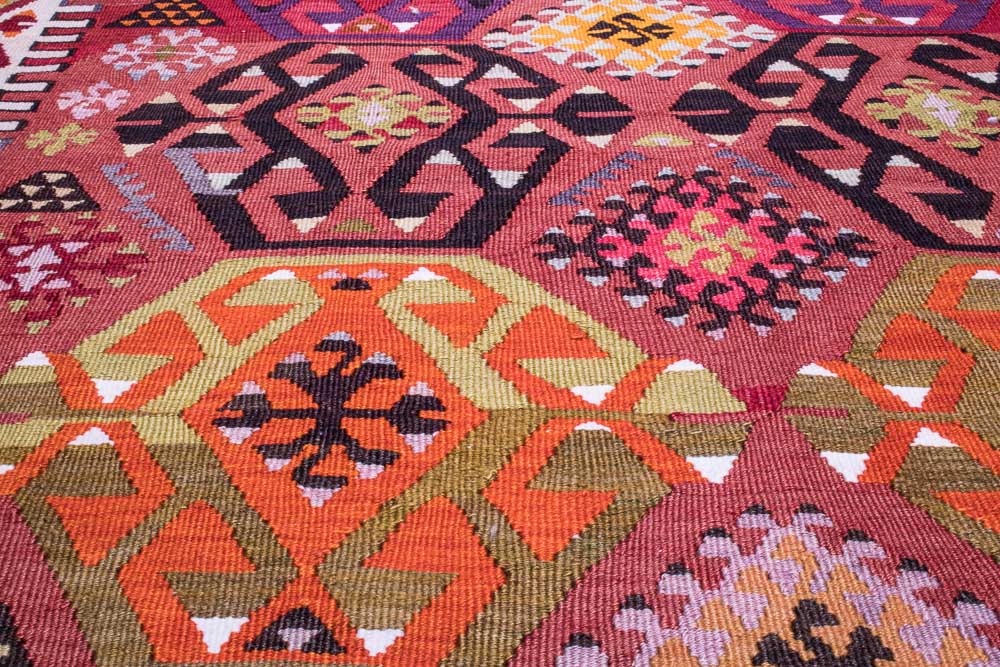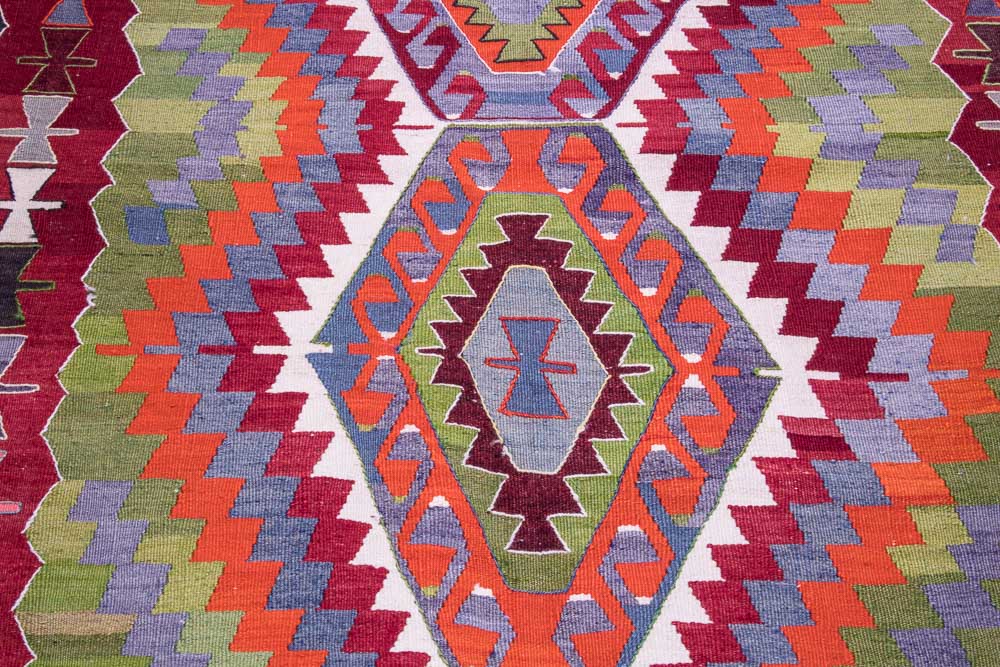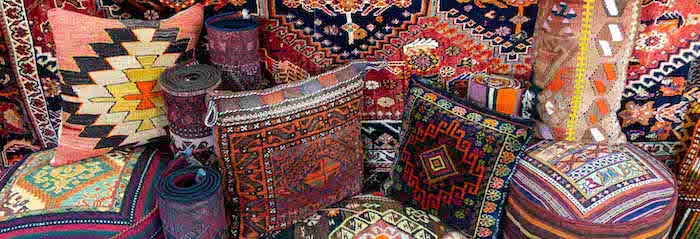About Turkish Kilims
Kilim is the best known type of flat weave, and an indispensable component of social life in Turkey. In recent years, being eloquent and stimulating works of art, Anatolian Kilims are highly esteemed by world public opinion and have assumed the place they deserve. Compared to the Kilims of other countries where similar weavings are produced, Anatolian Kilims display some differences in terms of general characteristics and are preferred by art enthusiasts all around the world.

The colours, motifs and compositions introduced by various cultures flowing from different directions to Anatolia which already had produced outstanding examples in the art of weaving lead to an incredible increase in the variety of these Kilims. The Turkish tribes moving into Anatolia have introduced new dimensions to the art of Kilim weaving. Research indicates that Turks had an established weaving tradition before they came to Anatolia, pile-knotted carpets, Kilims and other types of weaves being an important part of their life. Though produced for daily use, they are loaded with profound aesthetic values. Researchers believe that the colours and motifs used on Kilims display a type of symbolism which serves to differentiate various social groups from others.
![]() Some experts suggest that these motifs were transported to Anatolia, through the migration process of Turcoman groups, mixing as they do with the cultures in the regions they passed through, and intermingled with the already existing rich varieties of textiles in Anatolia to produce new variations. Migrations, marriages, friendship and kinship relations in different regions have led to flow of motifs from one region to another, causing an interaction, and the different colours, patterns and compositions brought in by these waves have occasionally increased diversity, while the motifs specific to a tribe or group were faithfully preserved.
Some experts suggest that these motifs were transported to Anatolia, through the migration process of Turcoman groups, mixing as they do with the cultures in the regions they passed through, and intermingled with the already existing rich varieties of textiles in Anatolia to produce new variations. Migrations, marriages, friendship and kinship relations in different regions have led to flow of motifs from one region to another, causing an interaction, and the different colours, patterns and compositions brought in by these waves have occasionally increased diversity, while the motifs specific to a tribe or group were faithfully preserved.
Kilims, which are generally woven by rural women in Anatolia, were produced in royal workshops during the Seljuk and Ottoman periods. Various sources state that, although there were specimens influenced by tribal Kilims. The designs of these Kilims were drawn by court designers to suit the various tastes of the period in terms of motifs and compositions and the weavers used these models in weaving. Such drawings are not used in the production of tribal Kilims. Even today, Anatolian women weave Kilims from memory/by heart without using any kind of drawing. It is known that the motifs are transferred from one generation to the other in a process where weavers learn from their mothers and grandmothers.
Although the Kilims which the Anatolian rural population, procuring the necessary material with their own means, produced for their own use are functional, they have an extraordinary decorative characteristic. The decorative characteristic is derived by the colour of natural dyes extracted from local plants, as well as the motifs and compositions which lead the viewers into a mysterious search for meaning every time they look at it. The fact that the variety of colour and richness of design displayed in Anatolian Kilims are observed in none of the Kilim weaving countries is accepted by numerous foreign scholars. The abundance and diversity of the cultural accumulation in Anatolia have created a very rich common language of motifs. The extraordinary artistic and technical level achieved by the women who probably have never left their villages or regions is met with worldwide excitement and appreciation.
![]() There is a widespread view that motifs used on Kilims have certain meanings and contain symbolic expressions. This quality assigned to Kilim motifs suggests that numerous values which has an importance for the people living in Anatolian rural settlements are reflected on Kilims through motifs symbolizing concepts pertaining to life such as birth, marriage, and death, as well as the desires to define and protect themselves against malice and secure fertility.
There is a widespread view that motifs used on Kilims have certain meanings and contain symbolic expressions. This quality assigned to Kilim motifs suggests that numerous values which has an importance for the people living in Anatolian rural settlements are reflected on Kilims through motifs symbolizing concepts pertaining to life such as birth, marriage, and death, as well as the desires to define and protect themselves against malice and secure fertility.
Some researchers trace the origins of motifs and their meaning back to the pre-historic period and ancient civilizations, while some hold the view that they are transferred to Anatolia via the migration of Turkic groups. In spite of the fact that the debate on the origins of motifs and compositions are not yet concluded, the researchers do not object the view that Kilim motifs have names or meanings. Some scientific circles accept the view that Kilim motifs are symbolic expressions reflecting universal concepts like birth, life and death which have been used since the oldest times in Anatolia.
 It is also observed that some motifs are assigned religious meanings. According to some researchers Anatolian women display a unique power of observation and a great skill in creating symbols. Due to traditions, they usually prefer to express their expectations and also themselves through symbols.
It is also observed that some motifs are assigned religious meanings. According to some researchers Anatolian women display a unique power of observation and a great skill in creating symbols. Due to traditions, they usually prefer to express their expectations and also themselves through symbols.
Elibelinde motif symbolising women, fertility and abundance, is still used in all regions of Anatolia under different names yet similar meanings. Elibelinde is a stylised female figure. It has been given various names, some of which are elibelinde (hands on hips), elibogrunde (hands on flank), ele gogsunde (hands on breasts), gelin kiz (bride), cocuklu kiz (girl with child), aman kiz (the mercy girl), seleser, kakullu kiz (gir with fringes). No other motif is known to be so widespread yet to carry a single meaning. Some scholars believe that elebelinde motif is the equivalent of the mother goddess and maintain that it is being used since the ancient cultures where woman was dominant and important to symbolise motherhood and fertility.
Kocboynuzu, though not as frequent as elibelinde, is another motif which frequently appear on Kilims. It is said to be a symbol of heroism, fertility, power and masculinity. It is also called by various names; kocboynuzu (ram’s horn), koc (ram), boynuzlu yanis (horn motif), koclu yanis (ram motif), gozlu koc basi (ram’s head with eyes) etc.
![]() According to some scholars, the wide use of protective motifs on Kilims results from the fact that the house, grain, animals and family are the most valuable assets of rural people. Protective motifs have a special place in Anatolian Kilims. Special motifs are used on the Kilims to protect marriages, spouses, family members, children, houses and grain, and animals against the evil eye and malice in the environment; such motifs include amulets, charms, scorpions, hands, fingers, eyes, crosses, hooks, burdocks, dragons and snakes.
According to some scholars, the wide use of protective motifs on Kilims results from the fact that the house, grain, animals and family are the most valuable assets of rural people. Protective motifs have a special place in Anatolian Kilims. Special motifs are used on the Kilims to protect marriages, spouses, family members, children, houses and grain, and animals against the evil eye and malice in the environment; such motifs include amulets, charms, scorpions, hands, fingers, eyes, crosses, hooks, burdocks, dragons and snakes.
There are also views which suggest claim that fertility is one of the prominent themes used on Anatolian Kilims. Sometimes with the aid of the male and female symbols, they express reproduction in marriage and family, other times they symbolise fertility of the grain and an increase in family income.
The tree of life, which appears in many cultures, is a motif frequently used in Anatolian Kilims. Some experts believe that it symbolises the uniqueness of the god, paradise and immortality. It is generally depicted with birds on it. According to the belief the birds will fly off the tree at the time of death.
It is suggested that the bird motifs carry various meanings. Good wishes, bad chance, death, soul, power, strength, happiness and many other concepts are symbolised with the several bird motifs on Kilims.

Currently, Anatolian women are interested in the names identifying the motifs rather than the meanings of motifs decorating their Kilims. However, with an instinct to protect the tradition they claim the rights of the designs attributed to their region and their culture and avoid reflecting the changes which inevitably take place in time, on the basic design.
Contemporary weavers have almost forgotten the ancient, and once widespread, belief that “kilims bring good luck”. When the weaving women are asked about the meanings of the motifs, they tend to say, “this is our tradition, custom, that’s how we’ve seen from our elders, that’s what we’ve learned” and state that they name the motifs after the objects they see around them. Names such a frog, cat, lamp, apple etc is a terminology they use among themselves to indicate which motif should be used where and these terms usually tend to change from one region to another.
From “Symbolic meanings and characteristics of Anatolian Kilim Motifs” written by Sahika Unal, Ankara, Turkey
Photos by Yashar Bish

